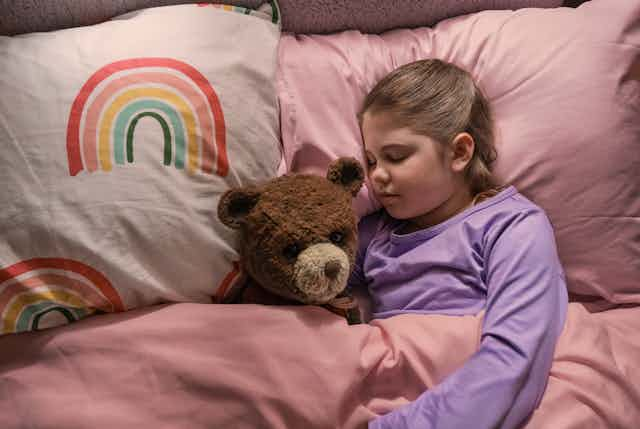I was hesitant to watch Imaginary. Not only because horror movies are often too scary for me, but also because, for the better part of my adult life, I’ve researched and studied the way children invent imaginary friends and there is widespread misunderstanding of what is perfectly normal play behaviour.
These misunderstanding sometimes lead people to think imaginary friends have supernatural explanations – especially when the typical play involves seeing and talking to things that are inanimate. But I was pleased to find that overall, the film is unusually well informed.
The movie’s main focus is an imaginary friend. He turns up unexpectedly after a family moves into the step mum’s childhood home – but soon after this, things start to get scary.
The film features a little-known form of imaginary companion – toys or dolls. In my own lectures I often ask for a show of hands for those who had imaginary friends as children. Typically, only a few students will raise their hand. But after explaining that the definition also includes dolls or toys imbued with personality the lecture hall usually gets louder and many more hands shoot up.
Both completely invisible beings and personified objects fall under the umbrella of imaginary companions. This is because creating invisible and personified companions involves creating, and interacting with, another mind.
Another accurate element of the film is the adult experience of imaginary companions. One of the adult characters (who I can’t name without spoiling the plot) had an imaginary companion in the past, but did not remember them until they were reminded later on in the movie.
Age affects the memory of our childhood imagination. The older we get, the more likely we are to forget. Even the organisers of studies of children sometimes consult parents or guardians to determine if there was an imaginary companion that children do not recall immediately.
Women and only or first-born children are more likely to create imaginary beings in childhood – and the film follows this pattern.
The presence of a companion in and of itself has been found to influence later adult life. Those that had imaginary companions in childhood are more likely to have creative jobs in adulthood. There are also accounts of imaginary companions beyond childhood. One large study of adults found that 7% of their respondents reported still having these imaginary beings in their lives.
When imaginary friends seem sinister
Something else Imaginary gets right is that invisible friends can easily be interpreted as eerie or supernatural. The reason that we scientists call imaginary friends by another name, imaginary companions, is because they are not always friends.
Some children have companions that are disobedient or even mean. This type of imaginary creature is not an indication of having a mental health issue, or any other problem. But the relationships between children and their imaginary companions fall on a continuum where some are quite agreeable and likeable while others are not.

Research indicates that the more that children play and interact with imaginary companions the more autonomous they may be becoming in their minds. This phenomenon is called the “illusion of independent agency”, and it applies to imaginary beings that are mean and vengeful, as well as ones that are compassionate and caring.
For a child, this might feel as if they are not in control of the companion’s actions or words. It could also feel like the being could surprise them, or even have an ability to learn things that the child doesn’t yet know. For example, in one of my studies, a child explained that when her parents are not looking, her imaginary companion teaches her maths. In some situations where a companion might be mean to a child, it could be upsetting.
But in reality, the child is still controlling the companion, they’re just not realising that the companion is not its own person. According to cognitive scientist Jim Davies, this should only happen when the imagined character is played with over time and understood by their creator, but would not be likely in a new creation.
Imaginary friends in the film
There are some scenes in Imaginary where the young girl, Alice (Pyper Braun), is talking to her imaginary companion and making responses as well. She is completely alone and doesn’t know anyone else is watching her.
Although it may look a bit creepy, this is actually a very accurate portrayal of companion play. The type of speech that Alice is engaging in when they are talking to and fro in conversation with their imaginary being is called “private speech”.
Private speech is thought to be imperative in the formation of our verbal thoughts and links our inner dialogue to words that we use in our social world. In one of my own studies, we found that children with imaginary companions not only showed more private speech than their peers, but their private speech was developmentally more sophisticated.
Of course as the film goes on there are much less realistic and accurate portrayals of imaginary companions – but that makes sense for a horror film. In the real world, children’s imaginary friends are usually nothing to be afraid of.

Looking for something good? Cut through the noise with a carefully curated selection of the latest releases, live events and exhibitions, straight to your inbox every fortnight, on Fridays. Sign up here.

